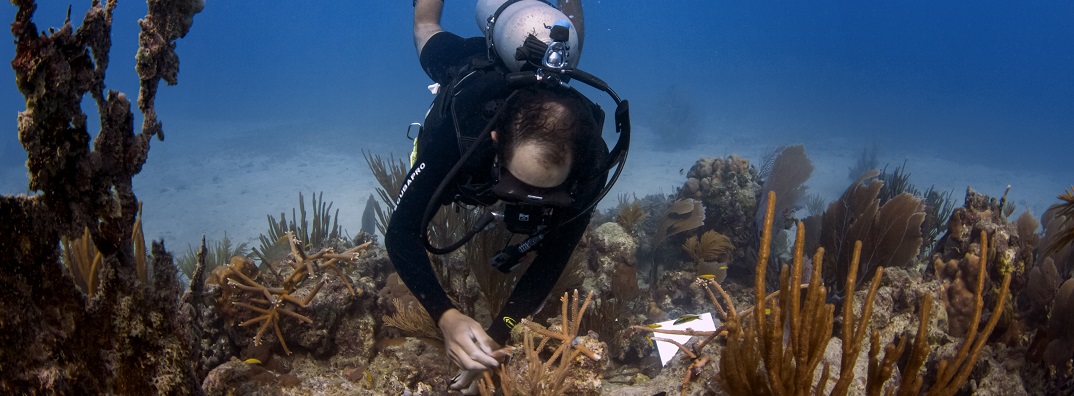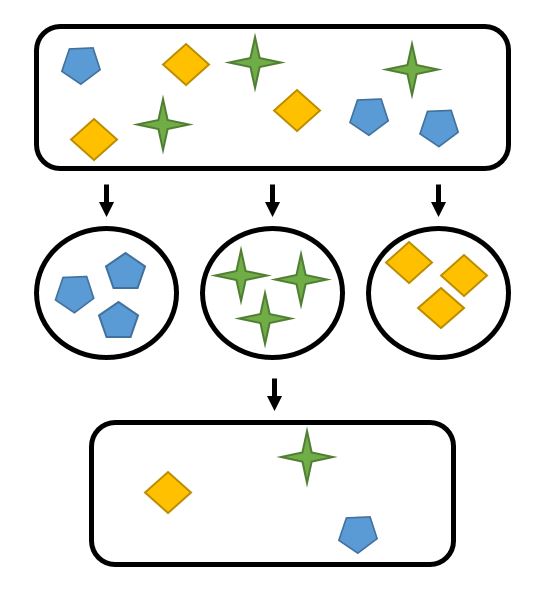- ABOUT US
- PROGRAM AREAS
- CONSERVATION APPROACH
- EDUCATION
- MULTIMEDIA
Monitoring Coral Reefs to Understand Trends in Space and Time
By Erica K. Towle, Ph.D., National Coral Reef Monitoring Program coordinator

Have you ever wondered how coral scientists can track how coral reefs are doing? How can we compare one coral reef area to another? How do we know if coral reef condition is changing over time? NOAA’s Coral Reef Conservation Program monitors coral reefs at two different scales in order to help answer those questions.

If we want to know how coral reefs are doing broadly for a given region or compared to other regions, we can use data collected by the National Coral Reef Monitoring Program (NCRMP). This program covers all U.S. states and territories that have coral reefs and uses the same methods in each region to collect data on corals and algae, fish, climate, and social science indicators. NCRMP uses a sampling design that is called “stratified random sampling.” It means that we survey randomly throughout given areas, for example, sites between 0-30m depth that have a hard bottom. Random site selection means we are not selecting for specific conditions like sites with the best coral cover. Random site selection allows us to see a representative range of all the sites in a given area—sites that are in good condition, sites that are doing alright, and sites that are not doing as well. This random, representative sample allows us to say something about the jurisdiction or sub-region on the whole.
Let’s use Florida’s Coral Reef as an example. Using NCRMP data, we can say something about how the reefs of Florida are doing on the whole, and we can even break that down to sub-regions, like how the reefs in Southeast Florida are doing compared to the reefs of the Florida Keys.
But what if someone wanted to know about a particular reef site? NCRMP would not be a good dataset to use in that case because we do not study the same sites over time (remember, random sampling!). So in this case, we would want to use a fixed site monitoring design. The Coral Reef Conservation Program supports fixed site monitoring in the states and territories through our grants and cooperative agreements. Usually these local monitoring programs consist of a set number of sites that the monitoring team goes back to year after year! This type of monitoring is especially useful for answering specific questions about how a popular snorkeling or diving site may be changing over time, or whether a coral restoration project is successful at a given location.
The questions you want to answer are important in designing a monitoring program, and sometimes, you may want to consider a mix of both random and fixed sites! In general, a random-site design that allows you to see the bigger picture of what’s happening at a regional scale can help put a fixed-site design in perspective to help you key in on what’s happening at a specific place.
If you want to learn more about how NCRMP data can tell us about the status of a reef site overall and by sub-region, check out the NCRMP Status Reports. If you want to learn more about other projects that the Coral Reef Conservation Program supports through our competitive grants, such as the Jurisdictional Awards that support local, fixed-site monitoring, check out Coral Reef Conservation Program Funded Projects.
About Us

The NOAA Coral Reef Conservation Program was established in 2000 by the Coral Reef Conservation Act. Headquartered in Silver Spring, Maryland, the program is part of NOAA's Office for Coastal Management.

The Coral Reef Information System (CoRIS) is the program's information portal that provides access to NOAA coral reef data and products.
Work With US
U.S. Coral Reef Task Force
Funding Opportunities
Employment
Fellowship Program
Contracting Assistance
Graphic Identifier
Featured Stories Archive

Access the archive of featured stories here...
Feedback
Thank you for visiting NOAA’s Coral Reef Conservation Program online. Please take our website satisfaction survey. We welcome your ideas, comments, and feedback. Questions? Email coralreef@noaa.gov.
Stay Connected
Contact Us
NOAA’s Coral Reef Conservation Program
SSMC4, 10th Floor
1305 East West Highway
Silver Spring, MD 20910
coralreef@noaa.gov
